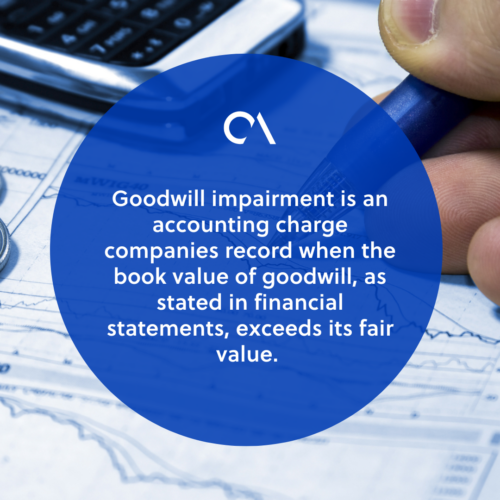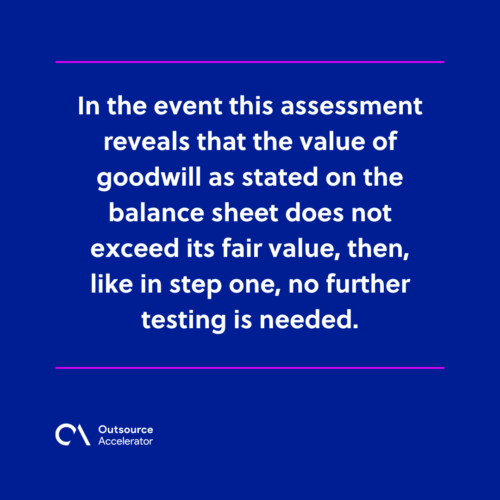Goodwill impairment 101: Definition, causes, testing, and calculations

Goodwill is an intangible asset associated with a company’s purchase of another company. It represents a value that can give the acquiring company a competitive advantage.
The acquisition of goodwill occurs when the price exceeds the total net fair value of all the assets and liabilities that come with the target company. It is subsequently recorded under the acquirer’s long-term assets account.
Aspects of goodwill include brand reputation, loyal customer base, good professional relations, outstanding customer service, and proprietary technology. These factors may urge an acquiring company to pay more than the fair value.
But what is “goodwill impairment?” What kind of situations could cause it? When should your company conduct a goodwill impairment test? Lastly, how is goodwill impairment calculated?
Let’s start by establishing what exactly goodwill impairment is.
What is goodwill impairment?
Goodwill impairment is an accounting charge companies record when the book value of goodwill, as stated in financial statements, exceeds its fair value.
When recorded, impairments result in the recognition of a loss in their respective period.

Goodwill impairment can cause concern, particularly during recessionary periods when cash flows from operations are more likely to decline. As a result, goodwill charge-offs to “expense during recessions are unusually large.
Many businesses incorporate recession-proof strategies into their organization for survival.
Causes of goodwill impairment: When and why does it happen?
Goodwill impairment happens when there is a decline in the capabilities of acquired entities to generate cash flows, which reduces the goodwill’s fair value even below its book value.
In other words, goodwill impairment arises when the book value of a goodwill asset is greater than its fair value. The amount of the impairment, then, is the difference between these two values.
Goodwill impairment testing
A goodwill impairment test is required at least once a year at a reporting level. This is in accordance with the generally accepted accounting principles (GAAP).
Companies are to evaluate the goodwill value on their financial statements and record impairments, if there are any.
A reporting unit is a business unit that a company’s management recognizes as a separate segment and is reviewed and evaluated as such. It plays a crucial role during the testing of impairment to goodwill.
Reporting units usually represent either geographic units, distinct business lines, or subsidiary companies.
An annual goodwill impairment test is required as the minimum. However, on occasion, there will be events that trigger impairment. In this case, a company conducts a goodwill impairment test beyond the one required once a year.
Events and indicators that could urge companies to run an impairment test include:
- Adverse changes in economic conditions
- Increase of competition
- Changes in key personnel
- Legal implications
- Deteriorating cash flows
- Assets showing a pattern of declining market value
The basic procedure that governs goodwill impairment tests is set out by the Financial Accounting Standards Board (FASB).
An impairment test is done in three stages:
Step 1: Preliminary qualitative assessment
In this stage, the company must determine whether or not the goodwill carried on its balance sheet is likely to exceed its fair market value. This should be based on all relevant factors, such as the events and indicators mentioned earlier.
If this assessment shows that the book value of the goodwill isn’t likely to exceed its fair value, then there would be no need for further testing.
But if the result yielded is the opposite, then the company should proceed to the next step, which is the first stage of a two-stage quantitative assessment.
Step 2: Stage one of quantitative assessment
For this next step, the reporting unit’s fair value is calculated. Once that is done, that fair value is compared to the amount of goodwill that is currently carried on the company’s balance sheet.
During this stage, the company must assess the relative impact of all factors that may have tangibly affected the value of the goodwill asset.
In the event this assessment reveals that the value of goodwill as stated on the balance sheet does not exceed its fair value, then, like in step one, no further testing is needed.
If it’s revealed that the recorded goodwill exceeds its fair value, then the company must proceed to the step below.

Step 3: Stage two of quantitative assessment
The company then examines the value of the reporting unit’s individual assets and liabilities. This is done to determine that unit’s fair value.
If, after this examination, the reporting unit’s goodwill exceeds its fair value, then the excess goodwill is defined as an impairment to goodwill.
The value of this impairment is afterward reported as a goodwill impairment charge in the company’s financial statements.
How do you calculate goodwill impairment?
The exact amount of goodwill impairment can be subject to interpretation.
This is due to the fact that impairment is supposed to be the difference between the book value of a reporting unit and its fair value, which is difficult to calculate.
The common approach to this is to derive fair value by creating a projected cash flow model.
The calculation of goodwill, on the other hand, is fairly straightforward. To calculate goodwill, take the total net fair market value of the target company’s assets and liabilities, and subtract it from the purchase price.







 Independent
Independent




